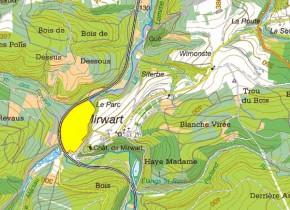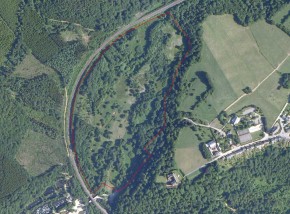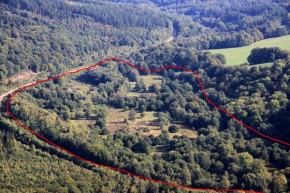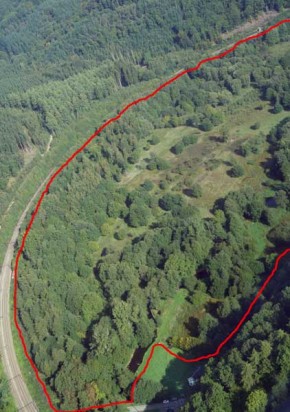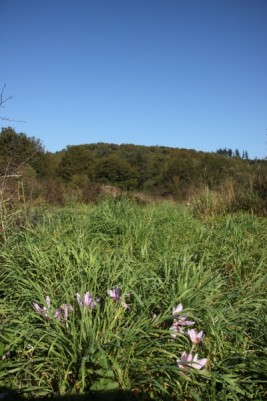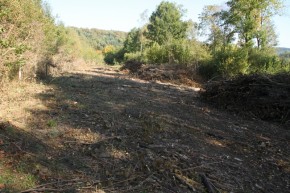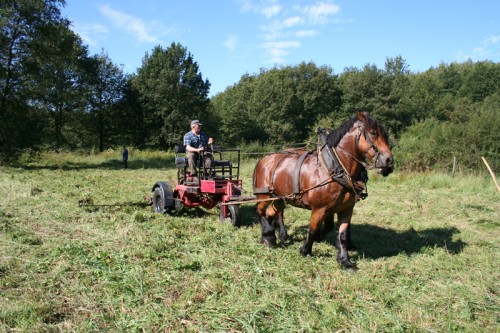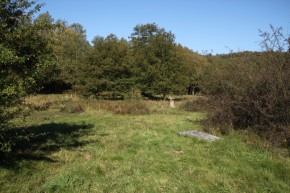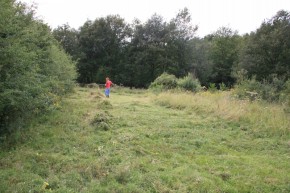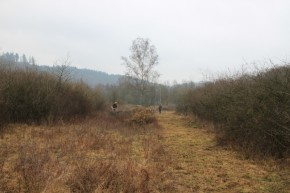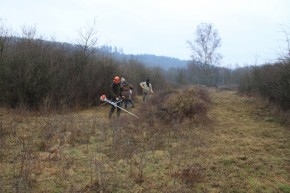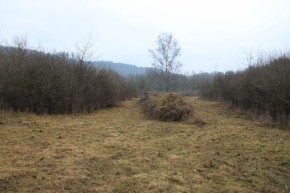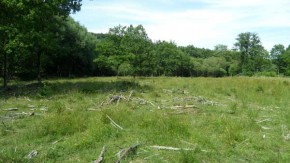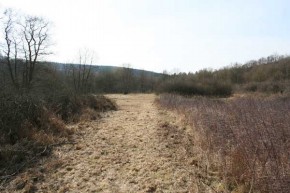FR
![]()
|  |
Localisation du site
Localisation du SGIB 75 - Pré des Forges |
Vue aérienne du SGIB en début de projet (orthophoto de 2007). Zoom sur la carte (JPG-622 ko) |
Informations descriptives et biologiques
Voir la fiche SGIB 75
Vues aériennes
Septembre 2010 - - vue générale sur la RND du Pré des Forges |
|
Actualité illustrée du site
Octobre 2011 |
Octobre 2011 - Une grande partie de la réserve va être déboisée dans le cadre du projet LIFE. Le "Pré" des Forges avait plutôt pris l'allure d'un parc forestier ces dernières années. La ré-ouverture du milieu permettra de restaurer des prairies alluviales et de tenter de diminuer l'impact du sanglier dans la réserve en supprimant la plupart des chênes (sources de nourriture, les glands) et en supprimant de nombreuses caches (buissons). Pour sortir les bois exploités, un layon est d'abord créé manuellement afin de créer un passage sur la bordure sèche de la réserve. |
Août 2011 - Deux zones de la réserve naturelle sont fauchées. C'est la technique de la fauche par traction chevaline qui est testée. Après un essai peu concluant, le système a été amélioré et donne un très bon résultat. |
Août 2011 - Une dizaine de tôles sont placées au pied de fourrés de pruneliers. On espère que la Vipère péliade appréciera ces caches rapidement chauffées par le soleil. |
Août 2011 - La journée de débroussaillage hivernal n'a pas pu venir à bout de toute la superficie à traiter. Une équipe réduite finalise le travail en août et s'attaque aux jeunes pruneliers restants. |
Février 2011 - Quelques bénévoles ont l'habitude de retrousser leurs manches pendant la période hivernale et de débroussailler partiellement l'exclos central de la réserve (zone non pâturée). En 2011, l'équipe LIFE a rejoint les troupes. Le travail a pour objectif principal de favoriser les jeunes stades de recolonisation par le prunelier. Ceux-ci conviennent en effet tout particulièremet à la Vipère péliade, une espèce-cible de la réserve naturelle. |
Juillet 2010 - Vue de la récente mise à blanc, entre l'exclos central de la RND et le talus du chemin de fer |
Mars 2010 - Une partie de la réserve n'est pas pâturée (exclos inaccessible aux vaches Highland). La gestion pratiquée vise essentiellement à créer des habitats favorables à la vipère péliade, notamment par la conservation de jeunes fourrés de prunelliers. |
EN
![]()
|  |
Location of the site
Location of the SGIB 75 - Pré des Forges |
V Aerial view of the SGIB at the beginning of the project (orthophoto from 2007) . Zoom on the map (JPG-622 ko) |
Descriptive and biological information
See file SGIB 75
Aerial views
Septembre 2010 - - general view over the Pré des Forges |
|
Current situation of the site
October 2011 |
October 2011- A large part of the reserve is going to be deforested as part of the LIFE project. The "Pré" des Forges had been gradually turning into a forest park in recent years. The reopening of the area will allow the alluvial prairies to be restored and an attempt to be made to mitigate the impact of the wild boar found on the reserve by removing the majority of the oaks (sources of food, mast) and by removing their cover in several places (bushes). To transport away the wood that has been removed, a path is first created manually in order to open up a passageway on the dry edges of the reserve. |
August 2011 – Two areas of the nature reserve are mown. The technique of mowing using horse traction is tested. After a rather inconclusive trial, the system was improved to produce a very good result. |
August 2011 – A dozen sheets of metal are placed at the base of blackthorn thickets. It is hoped that the European adder will appreciate these layers which are quickly warmed by the sun. |
August 2011 – The day of winter clearing was not able to cover the whole area that needed to be cleared. A small team finished the work in August and attacked the remaining young blackthorns. |
February 2011 – Some volunteers are used to rolling up their sleeves during the winter period and partially clearing the central enclosure of the reserve (non-grazed area). In 2011, the LIFE team joined their ranks. The main objective of the work is to promote the early stages of recolonisation by the blackthorn. This is particularly beneficial for the European adder, a target species in the nature reserve. |
July 2010 – View of the recent clearing, between the central enclosure of the RND and the railway embankment |
March 2010 – Part of the reserve is not being grazed (enclosure is inaccessible to the Highland cows). This management practice essentially aims to create a favourable habitat for the European adder, in particular by conserving young blackthorn thickets. |

